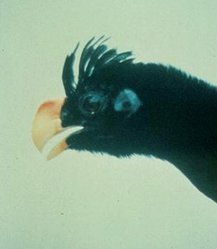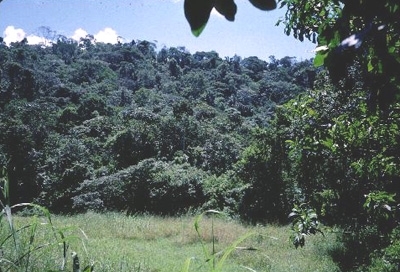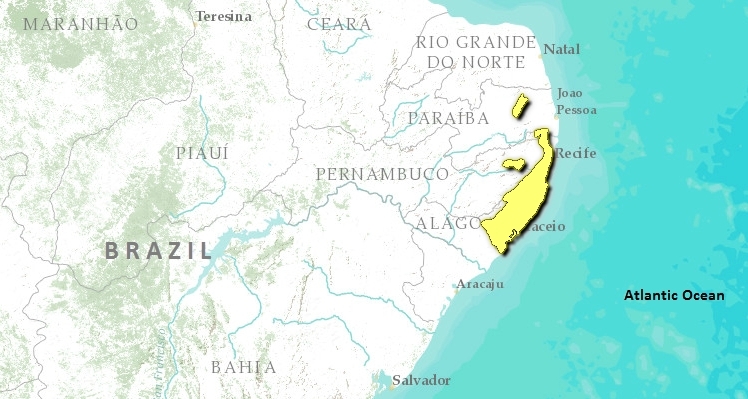Pernambuco coastal forests
Pernambuco coastal forests is a tropical moist forest covering an 80 kilometer (km) strip along the northeast coast of Brazil. The climate is tropical and the four-strata vegetation provides for a high level of biodiversity. This area is considered one of the more distinctive centers of endemism in South America. The ecoregion is considered an Endemic Bird Area, and harbors a number of threatened avifauna species. Four percent of the original forests remain, the largest of which is only about two hundred and thirty square kilometers. Most of the remaining habitat occurs in patches of less than one square kilometer. The land has been changed by logging, sugar plantations, and cattle ranching.
Location and General Description
Pernambuco coastal forests cover an 80-km wide strip along the Atlantic Coast of northeastern Brazil. The climate is tropical with annual rainfall ranging from 1,750 to 2,000 millimeters (mm). There is a dry period from October through January. Forests cover Tertiary sedimentary plateaus and ancient slopes of the Borborema Plateau. The Mundaú and Goiânia Rivers are the ecoregion's southern and northern limits, respectively. It is bordered on the west by Pernambuco interior forests. Tropical nutrient-impoverished soils (yellow-red latosols, podzols and lithosols) are dominant. Forest spreads from low-elevation plateaus only 20 meters in elevation to the windward slopes of Borborema at 600 to 800 m elevation. The main type of vegetation is the Atlantic moist forest, a four-strata vegetation with emergent trees taller than 35 m. Emergent and canopy layers are rich in tree species of Leguminosae (Parkia pendula), Sapotaceae (Manilkara salzmanii) and Lecythidaceae (Lecythis pisonis).
Biodiversity Features
 Alagoas curassow. (Photograph by WWF)
Alagoas curassow. (Photograph by WWF) Pernambuco coastal forests together with Pernambuco interior forests comprise one of the more distinctive centers of endemism in South America. The biological uniqueness of this area has been recognized by biogeographic studies plants, birds and butterflies. BirdLife International has also recognized the importance of this region, ranking it as an Endemic Bird Area. Although united by the presence of several endemic species, Pernambuco coastal forests are easily separated from Pernambuco interior forests by a set of ecological and biogeographic features that include climate, geomorphology and floristic composition. Pernambuco coastal forests harbor one of the forest sites with the largest number of threatened bird species (13) in South America. Alagoas curassow, Mitu mitu, a large and extraordinary bird considered extinct in the wild, was possibly restricted to the Pernambuco coastal forests. Although 96 percent of the Pernambuco coastal forests have been removed, the largest forest remnants are still very important from a conservation viewpoint. They harbor, among important species of other groups of organisms, viable populations of a number of small-bodied endemic birds (mostly passerines) and the last populations of the red-handed howler monkey (Alouatta belzebul) in the [[Brazil]ian] Atlantic forest.
Current Status
Most of the Pernambuco coastal forests have been cleared in the last centuries. First, the extraction of Brazil wood ("Pau Brazil") was the main goal. This cycle was followed by a long period in which the sugarcane industry was mainly responsible for most of the clearing. Today, even though forest remnants are legally protected, forest conversion into agricultural fields, logging and hunting still persist. Remaining natural vegetation is represented by 233.3 km2 of moist forests, with the last largest blocks of habitat (10 to 20 km2) in private ownership. Thousands of 0.01 to 0.1 km2 remnants surrounded by sugarcane fields compose the dominant landscape in this ecoregion. Protected areas cover 87 km2 of lowland moist forest, but these reserves are few (41), too small (97 percent are smaller than 10 km2) and isolated to maintain most of the biodiversity and key ecological processes.
Types and Severity of Threats
Although sugarcane plantations are declining, their replacement by other economic activities such as cattle ranching will probably maintain the high pressure on the last forest remnants. Key ecological processes such as seed dispersal have been critically modified by the extirpation of the large mammal and bird frugivores.
Justification of Ecoregion Delineation
Pernambuco coastal forests are recognized as a distinct type of humid Atlantic forest by several authors due to their endemic species and distinctive plant and animal communities. This northern coastal patch of Brazil’s Mata Atlantica forests are unique in floral and faunal endemism. Much of the current vegetation has been converted to agriculture, so linework for this ecoregion was derived from IBGE to estimate historic ranges by following their classification of "open ombrophilous forest: secondary vegetation and agricultural activities" and then incorporating "Atlantic dense ombrophilous forest: secondary vegetation and agricultural activities" in the state of Pernambuco, Brazil. Linework was reviewed and modified during an ecoregional workshop covering Brazil’s Atlantic forests. Results of this workshop are also available.
Additional Information on this Ecoregion
- For a shorter summary of this entry, see the WWF WildWorld profile of this ecoregion.
- To see the species that live in this ecoregion, including images and threat levels, see the WWF Wildfinder description of this ecoregion.
- World Wildlife Fund Homepage
Further Reading
- Almeida, R.T., D.S. Pimentel, and E.M.C. Silva. 1995. The red-handed howling monkey in the State of Pernambuco, North-east Brazil. Neotropical Primates 3: 174-176.
- Andrade-Lima, D.A. 1957. Estudos fitogeográficos de Pernambuco. Boletim do Instituto de Pesquisas Agronômicas de Pernambuco 2:1-44.
- Brown, Jr. K.S. 1987. Biogeography and evolution of neotropical butterflies. Pages 66-104 in T.C. Whitmore, and G.T. Prance, editors, Biogeography and Quaternary history in tropical America. Claredon Press, Oxford. ISBN: 0198545460
- Coimbra-Filho, A.F., and Câmara, I.G. 1996. Os limites originais do Bioma Mata Atlântica na região Nordeste do Brasil. FBCN, Rio de Janeiro.
- Conservation International do Brazil, Fundacao SOS Mata Atlantica, Fundacao Biodiversitas, Instituto de Pesquisas Ecologicas, Secretaria do Meio Ambiente do Estado de Sao Paulo, SEMAD/Instituto Estadual de Florestas-MG. Brasilia. 1999. Avaliacao e acoes prioritarias para a conservacao de biodiversidade de Mata Atlantica e Campos Sulinos, MMA/SBF, 2000. 40p.
- Coutinho, R.Q., M.F. Lima-Filho, J.B. Souza-Neto, and E.P. Silva. 1998. Características climáticas, geológicas, geomorfológicas e geotécnicas da Reserva Ecológica de Dois Irmãos. Pages 21-50 in I.C. Machado, A.V. Lopes, and K.C. Pôrto, (orgs.). Reserva Ecológica de Dois Irmãos: estudos em um remanescente de Mata Atlântica em àrea urbana (Recife, Pernambuco, Brasil). Editora Universitária da UFPE, Recife.
- Experts workshop for ecoregional priority setting. 10-14 August, 1999, Atibaia, Sao Paulo, Brazil.
- Fundação Instituto Brasilero de Geografia Estatástica-IBGE. 1993. Mapa de vegetação do Brasil. Map 1:5,000,000. Rio de Janeiro, Brazil.
- Haffer, J. 1987. Biogeography of neotropical birds. Pages 105-150 in T.C. Whitmore, and G.T. Prance, eds.). Biogeography and Quaternary history in tropical America. Claredon Press, Oxford. ISBN: 0198545460
- IBGE. 1985. Atlas Nacional do Brasil: Região Nordeste. IBGE, Rio de Janeiro.
- Lima, A.R., and Capobianco, J.P.R. (Org.). 1997. Mata Atlântica: avanços legais e institucionais para sua conservação. Documentos do ISA no. 4.
- Mendes, S.L. 1999. Grupo mamíferos- documento preliminar. In Conservation International, editor. Workshop Avaliação e Ações Prioritárias para Conservação dos Biomas Floresta Atlântica e Campos Sulinos, São Paulo. http//www.conservation.org.
- Pennington T.D. 1990. Sapotaceae. Flora Neotropica, monograph n° 52.
- Prance, G.T. 1987. Biogeography of neotropical plants. Pages 175-196 in T.C. Whitmore, and G.T. Prance, editors, Biogeography and Quaternary history in tropical America. Claredon Press, Oxford. ISBN: 0198545460
- Ranta, P., Blom, T., Niemela, J., Joensuu, E. & Siitonen, M. 1998. The fragmented Atlantic rain forest of Brazil: size, shape and distribution of forest fragments. Biodiversity and Conservation 7: 385-403.
- Sick, H. 1993. Birds in Brazil. Princeton University Press. ISBN: 0691085692
- Silva, J.M.C,a nd ELLI, M. 2000. Tree species impoverishment and the future flora of the Atlantic forest of northeast Brazil. Nature 404:72-74.
- Veloso, H. P., A.L.R. Rangel-Filho, and J.C.A. Lima. 1991. Classificação da vegetação brasileira adaptada a um sistema universal. IBGE, Rio de Janeiro.
- Wege, D.C., and Long, A. J. 1993. Key areas for threatened birds in the neotropics. BirdLife Conservation Series No. 5.
| Disclaimer: This article is taken wholly from, or contains information that was originally published by, the World Wildlife Fund. Topic editors and authors for the Encyclopedia of Earth may have edited its content or added new information. The use of information from the World Wildlife Fund should not be construed as support for or endorsement by that organization for any new information added by EoE personnel, or for any editing of the original content. |

